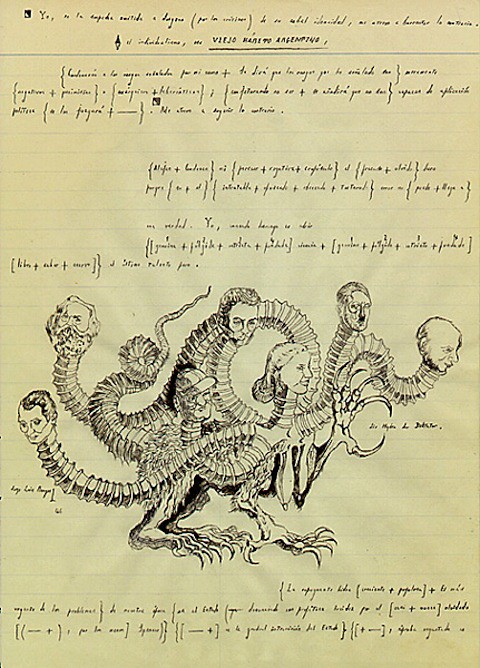You are using an out of date browser. It may not display this or other websites correctly.
You should upgrade or use an alternative browser.
You should upgrade or use an alternative browser.
bernardina
Moderator
The Banshee = Η Μπάνσχη = The "woman of the fairies" does not have a distinct shape, but is instead described by her keening wails.
Με την ευκαιρία να διορθώσω αυτή τη Μπάνσχη;

Καταρχάς προφέρεται Μπανσί ή Μπάνσι και στα ελληνικά έχει επικρατήσει ως αγγελοκρούστης= θηλυκό δαιμόνιο, προάγγελος του θανάτου.
Βλέπε και sidhe. προφέρεταιˈʃiː
Κατά τ' άλλα, ο κατάλογος μού προξένησε δέος!
bernardina
Moderator
Κι επειδή ουκ εά με ησυχάζειν το του Δαεμάνου πρόγκημα, ([nudge]) ;)
Ιδού απντέητ του φανταστικού για προχώου και μοδέρνους τύπους.
Ιδού απντέητ του φανταστικού για προχώου και μοδέρνους τύπους.
Να αναφέρουμε (αν δεν το ανέφερε ήδη κανείς άλλος) ότι ναι μεν δεν υπάρχει μυρμηγκολέων (Mermecolion όπως λες παρακάτω), υπάρχει ωστόσο μυρμηκολέων, αγγλικά antlion, ονομασία της εντυπωσιακής αρπακτικής προνύμφης των ειδών του γένους Myrmeleo.τον ανύπαρκτο μυρμηγκολέοντα

Attachments
Καλά έκανες, Μπέρνι, και σχολίασες την banshee. Έχει ίσως τη χειρότερη μεταγραφή.
Ένα μυαλό το έχουμε...
http://www.proz.com/kudoz/english_to_greek/zoology/4494262-ant_lion.html
... υπάρχει ωστόσο μυρμηκολέων, αγγλικά antlion
Ένα μυαλό το έχουμε...
http://www.proz.com/kudoz/english_to_greek/zoology/4494262-ant_lion.html
Rogerios
¥
Με την ευκαιρία να διορθώσω αυτή τη Μπάνσχη;

Καταρχάς προφέρεται Μπανσί ή Μπάνσι και στα ελληνικά έχει επικρατήσει ως αγγελοκρούστης= θηλυκό δαιμόνιο, προάγγελος του θανάτου.
Βλέπε και sidhe. προφέρεταιˈʃiː
Κατά τ' άλλα, ο κατάλογος μού προξένησε δέος!mg:
Πέστα, βρε Μπέρνη, ν' αγιάσει το στόμα σου. Κανείς δεν τόλμησε ακόμη να πει η Σούζι και οι Μπάνσχης!
bernardina
Moderator
Πέστα, βρε Μπέρνη, ν' αγιάσει το στόμα σου. Κανείς δεν τόλμησε ακόμη να πει η Σούζι και οι Μπάνσχης!
Αχ, πώς με νιώθεις, βρε Ρογήρε μου... :wub:
Και πού να δεις κάτι *Σιούξι που έχουν ακούσει τα ωραία και μικρά μου αυτάκια!
Έτσι προφέρεται, people! :bored::twit:
Rogerios
¥
Η Σούζη και οι Μπάνσηδες (ή Μπανσήδες; ) :laugh:
Μια χαρά μου φαίνεται και μου ακούγεται (στην πρώτη εκδοχή του).
Rogerios
¥
Και πού να δεις κάτι *Σιούξι που έχουν ακούσει τα ωραία και μικρά μου αυτάκια!
Και τα δικά μου (που δεν είναι απαραιτήτως ωραία)! :)
bernardina
Moderator
Η Σούζη και οι Μπάνσηδες (ή Μπανσήδες; ) :laugh:
Η Σούζη κι οι Αγγελοκρούστες. Η Σούζι και οι Λάμιες :laugh::laugh:
Με τη μικρολεπτομέρεια του ότι οι Μπανσίς είναι θηλυκές να κάνουμε το λωλό παγόνι; ;)
Rogerios
¥
Η Σούζη κι οι Αγγελοκρούστες. Η Σούζι και οι Λάμιες :laugh::laugh:
Με τη μικρολεπτομέρεια του ότι οι Μπανσίς είναι θηλυκές να κάνουμε το λωλό παγόνι; ;)
Να κρατήσουμε τη Σούζη και τις Λάμιες, κι ο Θεός ας ξεχωρίσει τους δικούς του! [τι να κάνουμε που όλες οι Μπάνσις του συγκροτήματος ήταν σερνικές;] ;) :)
bernardina
Moderator
Να κρατήσουμε τη Σούζη και τις Λάμιες, κι ο Θεός ας ξεχωρίσει τους δικούς του! [τι να κάνουμε που όλες οι Μπάνσις του συγκροτήματος ήταν σερνικές;] ;) :)
Ό,τι κάναμε και με τη Βασίλισσα. Να τους αγαπάμε και να τους απολαμβάνουμε. :wub:
...
...
- The Eloi and the Morlocks = Οι Ελόι και οι Μόρλοκ = In the setting of H. G. Wells' The Time Machine, it is suggested that humans evolve (or devolve) into two distinct species. The Eloi are thin and fragile artisans, living on fruits. The Morlocks are blind laborers, living underground and rising to the surface on moonless nights to feed on the Eloi.
Τω αγνώστω θεώ - Παύλος Σιδηρόπουλος & Σπυριδούλα
μέσα μου κρύβω μόρλοκς, μαύρα ξωτικά
μισώ μου 'πες το σώμα μου κι αρνιέμαι στα τυφλά
κι ουρλιάζω σιωπηλά
...
Ο Μπόρχες σχεδιάζει ένα φανταστικό πλάσμα, την Ύδρα των Δικτατόρων*:

Above, see another of Borges’ sketches, this one from the University of Virginia’s extensive Borges collection. The drawing appears in a manuscript titled “The Old Argentine Habit,” penned in 1946 and published (as “Our Poor Individualism”) in Borges’ 1952 essay collection Other Inquisitions. According to C. Jared Lowenstein, the drawing is titled in German, “Die Hydra der Diktator” (“The Hydra of the Dictators”) and depicts Rosas, Peron, Mussolini, Hitler, and Marx and is signed “Jorge Luis Borges 46.”
Lowenstein writes:
Josh Jones is a writer and musician based in Washington, DC.
Two Drawings by Jorge Luis Borges Illustrate the Author’s Obsessions
* Αν και το γερμανικό Diktator είναι ενικός, αν δεν κάνω λάθος, μ' αρέσει καλύτερα ο πληθυντικός στα ελληνικά.
Η Ύδρα του Δικτάτορα; Σε κατοικίδιο μού φέρνει.
Από το τανγκό, τον Γαρδέλ και το γαρδέλι.
Ο Μπόρχες σχεδιάζει ένα φανταστικό πλάσμα, την Ύδρα των Δικτατόρων*:

Above, see another of Borges’ sketches, this one from the University of Virginia’s extensive Borges collection. The drawing appears in a manuscript titled “The Old Argentine Habit,” penned in 1946 and published (as “Our Poor Individualism”) in Borges’ 1952 essay collection Other Inquisitions. According to C. Jared Lowenstein, the drawing is titled in German, “Die Hydra der Diktator” (“The Hydra of the Dictators”) and depicts Rosas, Peron, Mussolini, Hitler, and Marx and is signed “Jorge Luis Borges 46.”
Lowenstein writes:
The theme of the artwork is a stunning political statement by a writer who has often been deemed apolitical. It is also a remarkably detailed drawing, especially for someone who was losing his eyesight as Borges was at this time. This marvelous depiction supplements Borges’s declaration in his text that Argentineans see themselves as individuals, not as citizens of a specific nation.
It is indeed a remarkably detailed work. I only wish Borges had supplied illustrations for his Book of Imaginary Beings.
* Αν και το γερμανικό Diktator είναι ενικός, αν δεν κάνω λάθος, μ' αρέσει καλύτερα ο πληθυντικός στα ελληνικά.
Η Ύδρα του Δικτάτορα; Σε κατοικίδιο μού φέρνει.
Από το τανγκό, τον Γαρδέλ και το γαρδέλι.
Πληθυντικός και στα γερμανικά: Die Hydra der Diktatoren (εδώ π.χ. σε ραδιοφωνική εκπομπή, που προτάθηκε και για βραβείο στη Γερμανία)* Αν και το γερμανικό Diktator είναι ενικός, αν δεν κάνω λάθος, μ' αρέσει καλύτερα ο πληθυντικός στα ελληνικά.
Η Ύδρα του Δικτάτορα; Σε κατοικίδιο μού φέρνει.
Ten Things To Know About Medieval Monsters
In their new picture book published by the British Library, Medieval Monsters, medieval historian Damien Kempf and art historian Maria L. Gilbert explore the fantastic, grotesque and exuberant world of monsters in the Middle Ages through the images found in illuminated manuscripts, from dragons and demons to Yoda and hybrid creatures. The book has already attracted rave reviews...
[...]
10. They may look like Hollywood movie stars
http://britishlibrary.typepad.co.uk...n-things-to-know-about-medieval-monsters.html

Για τον σχεδιαστή του Γιόντα:
http://www.thewrap.com/movies/article/star-wars-makeup-artist-stuart-freeborn-has-died-76561/
In their new picture book published by the British Library, Medieval Monsters, medieval historian Damien Kempf and art historian Maria L. Gilbert explore the fantastic, grotesque and exuberant world of monsters in the Middle Ages through the images found in illuminated manuscripts, from dragons and demons to Yoda and hybrid creatures. The book has already attracted rave reviews...
[...]
10. They may look like Hollywood movie stars
http://britishlibrary.typepad.co.uk...n-things-to-know-about-medieval-monsters.html

Για τον σχεδιαστή του Γιόντα:
http://www.thewrap.com/movies/article/star-wars-makeup-artist-stuart-freeborn-has-died-76561/
Marinos
¥
The Lamed Wufniks = Οι κουτσοί Βούφνικς = There are precisely thirty-six Lamed Wufniks in existence. It is said that, without knowing it, they support the universe and affirm god. If one comes to realize their purpose, they immediately die and are replaced by another unsuspecting man.
Πάντα με ενοχλούσαν αυτοί οι κουτσοί Βούφνικς!
Lamed Vav Tzadikim, παναπεί οι Τριανταέξι Δίκαιοι ή κατά-περίπου-λέξη οι Λάμδα Σίγματαυ Δίκαιοι. Λαμέντ είναι το λάμδα, και κατά σύμπτωση έχει και στα εβραϊκά την ίδια αριθμητική αξία. Και κατά σύντμηση, Λάμεντ Βάβνικ, οι λάμδα-σίγμα-ταυίτες: The term lamedvavnik is derived from the Hebrew letters Lamed (L) and Vav (V), whose numerical value (see Gematria) adds up to 36. The "nik" at the end is a Russian or Yiddish suffix indicating "a person who..." (As in "Beatnik"; in English, this would be something like calling them "The Thirty-Sixers".)
http://en.wikipedia.org/wiki/Tzadikim_Nistarim
Άρα λάθος του μεταφραστή, που διάβασε το Lamed σαν να ήταν αγγλική λέξη κι όχι εβραϊκή.
Εμένα πάντως από τα τέρατα της Βρετανικής Βιβλιοθήκης μου άρεσαν πολλά, αλλά ξεχωρίζω αυτό:

On Patmos, John (the Evangelist probably)
wrote revelations, an apocalyptic prophecy.
A mischievous demon tried to spoil the plot
by sneakily stealing John’s ink pot.
γιατί μου θυμίζει έντονα τον Τιτίβιλλο.
Ποιος είναι ο Τιτίβιλλος;
Α, μα είναι ο δαίμονας που ταλαιπωρεί τους γραφείς γεννώντας τυπογραφικά λάθη!
Titivillus - the Typo Demon
Titivillus (sometimes spelled ‘Tutivillus’) is a demon. He works on behalf of Lucifer, or Satan, or Belphegor, and in the Middle Ages is the one who loves to introduce errors into a scribe’s work as soon as the scribe’s concentration lapses.
...........
In particular, Titivillus would note all the idle gossip and chit-chat that inevitably went on during the long church services. This was of course a warning to congregations that any lack of concentration during prayers would not go unnoticed or unpunished, since such negligence of their devotions was depriving God of the prayers and praise that were His due.
.........
In the good old days, time was not necessarily of the essence in a remote monastery when it came to producing an illuminated Bible (one with pages or initial letters richly decorated with gold, silver, or coloured designs). A scribe could toil for many years over a single great work. But in the Renaissance everything speeded up. The result was, predictably, a huge increase in the number of errors. But now the monks had a scapegoat: Titivillus. Errors and typos were not their fault; they were deliberately introduced by that demon.
..........
In the Internet age we need Titivillus more than ever. We need him in his role as gatherer of all the idle Internet Chat and gossip, to stop it overwhelming us. And we need him as the Renaissance scribes needed him, as a scapegoat: the malevolent entity upon whose head we can heap all the errors and typos and omissions and inaccuracies that we find daily on the Internet.
Titivillus (Wikipedia)
In an anonymous fifteenth-century English devotional treatise, Myroure of Oure Ladye, Titivillus introduced himself thus (I.xx.54):
“I am a poor devil, and my name ys Titivillus ... I must each day ... bring my master a thousand pokes full of failings, and of negligences in syllables and words”
Κατόπιν αυτών ποιο μουσικό κομμάτι ταιριάζει εδώ, Δαεμάνε;
Εμένα πάντως από τα τέρατα της Βρετανικής Βιβλιοθήκης μου άρεσαν πολλά, αλλά ξεχωρίζω αυτό:

On Patmos, John (the Evangelist probably)
wrote revelations, an apocalyptic prophecy.
A mischievous demon tried to spoil the plot
by sneakily stealing John’s ink pot.
γιατί μου θυμίζει έντονα τον Τιτίβιλλο.
Ποιος είναι ο Τιτίβιλλος;
Α, μα είναι ο δαίμονας που ταλαιπωρεί τους γραφείς γεννώντας τυπογραφικά λάθη!
Titivillus - the Typo Demon
Titivillus (sometimes spelled ‘Tutivillus’) is a demon. He works on behalf of Lucifer, or Satan, or Belphegor, and in the Middle Ages is the one who loves to introduce errors into a scribe’s work as soon as the scribe’s concentration lapses.
...........
In particular, Titivillus would note all the idle gossip and chit-chat that inevitably went on during the long church services. This was of course a warning to congregations that any lack of concentration during prayers would not go unnoticed or unpunished, since such negligence of their devotions was depriving God of the prayers and praise that were His due.
.........
In the good old days, time was not necessarily of the essence in a remote monastery when it came to producing an illuminated Bible (one with pages or initial letters richly decorated with gold, silver, or coloured designs). A scribe could toil for many years over a single great work. But in the Renaissance everything speeded up. The result was, predictably, a huge increase in the number of errors. But now the monks had a scapegoat: Titivillus. Errors and typos were not their fault; they were deliberately introduced by that demon.
..........
In the Internet age we need Titivillus more than ever. We need him in his role as gatherer of all the idle Internet Chat and gossip, to stop it overwhelming us. And we need him as the Renaissance scribes needed him, as a scapegoat: the malevolent entity upon whose head we can heap all the errors and typos and omissions and inaccuracies that we find daily on the Internet.
Titivillus (Wikipedia)
In an anonymous fifteenth-century English devotional treatise, Myroure of Oure Ladye, Titivillus introduced himself thus (I.xx.54):
“I am a poor devil, and my name ys Titivillus ... I must each day ... bring my master a thousand pokes full of failings, and of negligences in syllables and words”
Κατόπιν αυτών ποιο μουσικό κομμάτι ταιριάζει εδώ, Δαεμάνε;
Marinos
¥
Μέχρι να βρει το κομμάτι ο Δαεμάνος να αφήσω εδώ μια σημείωση για τον ισλαμικό Κεμπικέτς, τον δαίμονα που θεωρείται βασιλιάς των σκόρων. Γράφουν το όνομά του στα χειρόγραφα, ώστε να μην τα φάνε οι σκόροι από σεβασμό στο βασιλιά του. Είναι και ένα ωραίο τούρκικο περιοδικό με το ίδιο όνομα.
Εδώ βιβλιογραφία, εδώ μια πολύ σύντομη σημείωση στα αγγλικά που μοιάζει να είναι το μόνο ίχνος του δαίμονα στο αγγλόφωνο ίντερνετ. Εδώ λέει ότι επίσης είναι όνομα από βοτάνι.
Εδώ βιβλιογραφία, εδώ μια πολύ σύντομη σημείωση στα αγγλικά που μοιάζει να είναι το μόνο ίχνος του δαίμονα στο αγγλόφωνο ίντερνετ. Εδώ λέει ότι επίσης είναι όνομα από βοτάνι.


